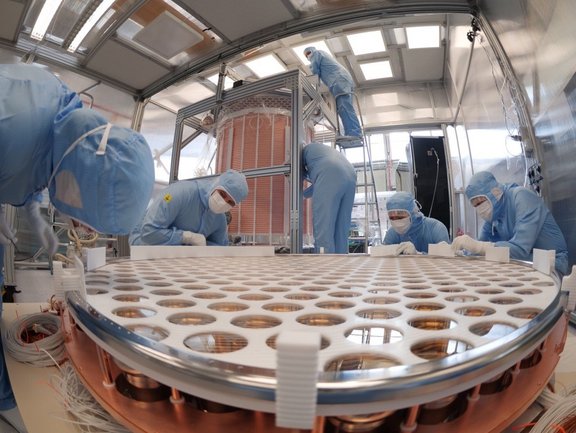The XENONnT experiment was designed to look for elusive dark matter particles. The detector holds almost 6000 kg of ultrapure liquid xenon as a target for particle interactions; it is installed inside a water Cherenkov active muon and neutron veto, deep underground at the INFN Laboratori Nazionali del Gran Sasso in Italy. Despite the challenging pandemic situation, XENONnT was constructed and subsequently commissioned between spring 2020 and spring 2021. XENONnT took the first science data over 97.1 days, from July 6 to November 10, 2021.
Experiments of this type require the lowest possible levels of natural radioactivity of any kind, both from sources intrinsically present in the liquid xenon target and from construction materials and the environment. The former, dominated by radon, is the most difficult to reduce and its elimination represents the holy grail of current searches at the sensitivity level of XENONnT. However, the XENON collaboration has been instrumental in reducing radon to an unprecedentedly low-level, thanks to extensive material screening and the successful operation of an online cryogenic distillation column that actively removes radon from the xenon.
Two years ago, the XENON collaboration announced the observation of an excess of electronic recoil events in the XENON1T experiment. The result triggered a lot of interest and many publications since this could be interpreted as a signal of new physics beyond known phenomena. Interactions with electrons in the atomic shell within the liquid xenon from solar axions, neutrinos with an anomalous magnetic moment, axion-like particles, or hypothetical dark sector particles might induce so-called “electronic recoil” signals. Today the XENON collaboration has released the first results from its new and more sensitive experiment, XENONnT, with one-fifth of the electronic recoil background of its predecessor, XENON1T. The absence of an excess in the new data indicates that the origin of the XENON1T signal was trace amounts of tritium in the liquid xenon, one of the hypotheses considered at the time. In consequence, this leads now to very strong limits on new physics scenarios originally invoked to explain an excess.
With this new result, obtained through a blind analysis, XENONnT makes its debut, with an initial exposure slightly larger than 1 tonne x year. The existing data are being further analyzed to search for weakly interacting massive particles (WIMPs), one of the most promising candidates of Dark Matter in the Universe. XENONnT is meanwhile collecting more data, aiming for even better sensitivity as part of its science program for the next years.
From Germany, the Max Planck Institute for Nuclear Physics in Heidelberg (MPIK), the universities in Freiburg, Mainz and Münster and the KIT in Karlsruhe are involved in XENON. The group at MPIK from Prof. Manfred Lindner's department has contributed centrally to the success of XENONnT at all levels: both in the planning and construction as well as in the operation and data analysis. The MPIK's expertise was particularly important in the development of the very sensitive and pure photosensors and the highly sensitive trace analytics. With the help of these, it was possible to select construction materials of the highest radioactive purity. In particular, the concentration of the radioactive noble gas radon − the dominant background source in XENON1T − could be improved by more than a factor of 5 compared to the previous experiment XENON1T in the interaction of this selection with an active xenon purification. Only this made the sensitive search for new physics possible at all.
[XENON collaboration]
Original publication:
Search for New Physics in Electronic Recoil Data from XENONnT, XENON Collaboration, PRL 129, 161805, DOI: 10.1103/PhysRevLett.129.161805
